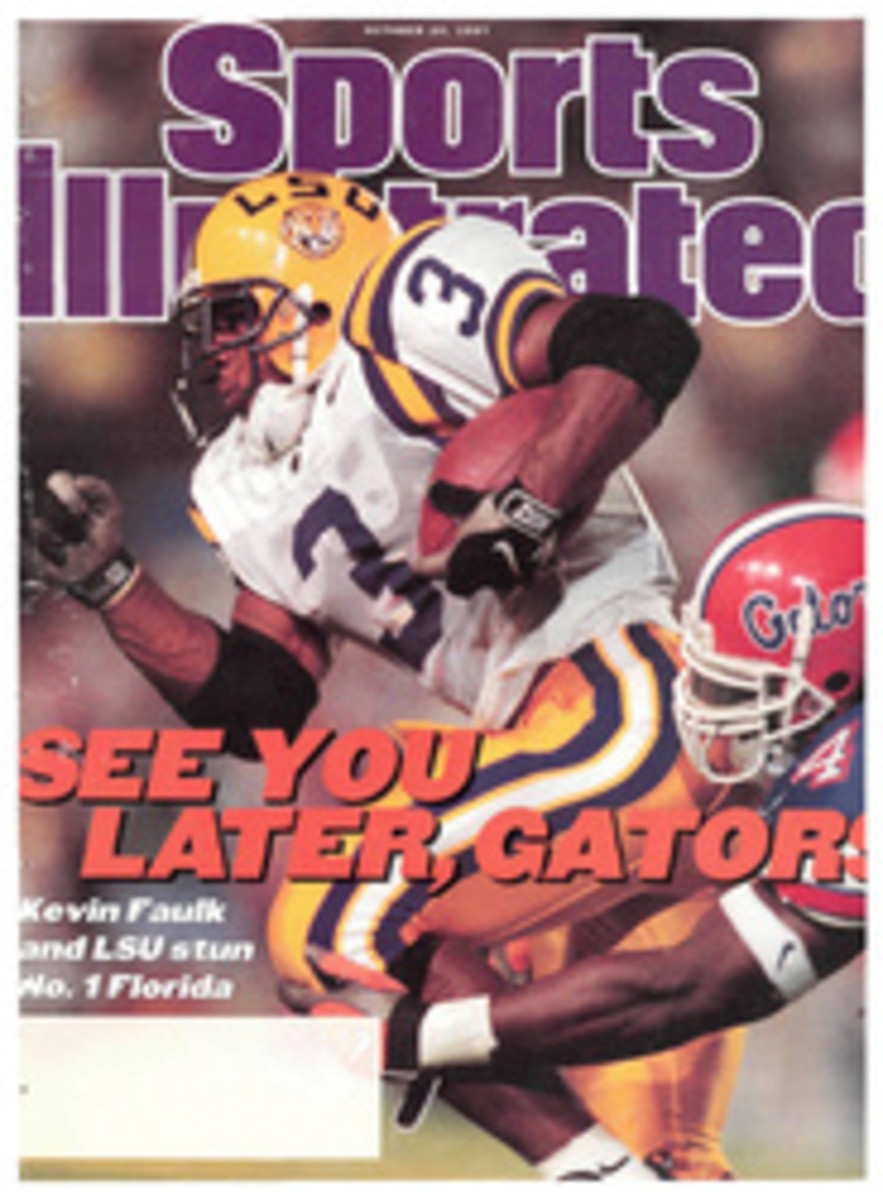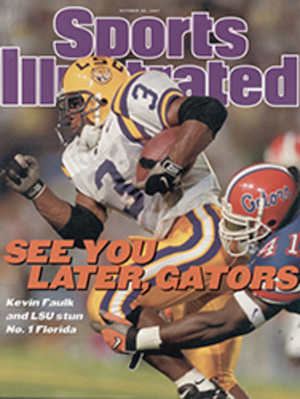
SPEED IS THEIR SPECIALTY WHEN NFL PLAYERS WANT TO GET QUICKER, THEY CALL ON A NEW BREED OF COACHES
San Francisco 49ers wide receiver J.J. Stokes was too busy
sucking air to discuss the workout he had just completed with 15
other players under the supervision of speed-enhancement coach
Ray Farris. Green Bay Packers backup quarterback Steve Bono's
body language--he was wobbling in small circles in a daze--said
that he wasn't available to comment on the various sprint drills
Farris had conducted at Menlo College, in Atherton, Calif., on
this sunny morning in June. "We only worked three hours today,"
said Farris, 32, who also trains Detroit Lions running back
Barry Sanders and Philadelphia Eagles running back Ricky
Watters. "I decided to take it easy on them."
Subjecting themselves to torturous workouts under merciless
speed-enhancement coaches is the latest off-season rage among
NFL players. Their motives are, of course, profits. For
athletes, quickness equals leverage in contract negotiations.
"It's mandatory that you run well to enhance your value," says
agent Roosevelt Barnes, whose clients include Lions rookie
cornerback Bryant Westbrook and Arizona Cardinals defensive end
Simeon Rice. Agents and players believe that a speed trainer can
add millions to a player's net worth by slicing hundredths of a
second from his 40-yard-dash time.
Anxious draftees and determined veterans enlist for three to six
months of off-season training, at about $500 per week, with
specialists such as Farris; Thomas Shaw, who works out of New
Orleans; and Rahn Sheffield, who is based in San Diego. Speed
specialists, unlike personal trainers and track coaches,
concentrate on making players faster through conditioning
programs designed specifically for football.
The demands of these programs are borderline sadistic. Nothing
satisfies some speed-enhancement coaches more than the sight of
an All-Pro dropping to his knees and gasping for air after a
workout. "Some trainers only do what the athlete thinks needs to
be done," says Farris, who was a speedy cornerback at Utah State
from 1983 to '85. "I know how to train winners. When they're
tired and saying, 'F--- you, Ray!' I know I'm doing my job."
The suffering often pays off. Last April one of Shaw's projects,
Florida State offensive lineman Walter Jones, who stands 6'5"
and weighs 305 pounds, shocked NFL scouts at a workout by
running the 40 in 4.57 seconds, easily surpassing his previous
best of 4.7. Afterward the exhilarated Jones ignored the open
arms of both his college position coach, Jimmy Heggins, and his
agent, Barnes, and gave Shaw a bear hug. "Coach, thank you,"
gushed Jones, who was selected by the Seattle Seahawks with the
sixth pick of the draft. "I never could have run it without you."
While under Sheffield's tutelage in the early 1990s, Tennessee
Oilers running back Ronnie Harmon, then with the San Diego
Chargers, cut his 40 time from 4.6 to 4.3, a speed most
defenders can't match. Harmon became one of the league's most
prolific receivers out of the backfield.
Such tortoise-to-hare transformations haven't been enough to
persuade NFL general managers to put speed-enhancement
specialists on the team payroll. "Most NFL coaches recommend
that their players train with these guys after the season," says
New England Patriots defensive coordinator Steve Sidwell. "But
teams don't have them on staff because they could interfere with
the team trainer's own program."
"If I was on an NFL team," says Shaw, "I'd have to fight to get
players to do my workouts. During the off-season most of them
are just happy sitting around spending their money."
Farris's notoriously tough eight-week hill-training sessions
have humbled even the fittest athletes. When Watters and Sanders
first attempted the winding 2.5-mile trail marked by Farris up
and down a San Carlos, Calif., slope, "they could barely do it,"
Farris says. "We kicked their asses on that thing." This drill
is borrowed from Hall of Fame Chicago Bears running back Walter
Payton, with refinements suggested by conditioning freak Roger
Craig, the former 49ers running back. The sessions require a
full range of motion in the leg muscles, thus strengthening the
entire leg.
Field work, such as the short dashes and wide receiver
pass-pattern drills that KO'd Stokes & Co. last summer, maintain
the fast-twitch muscle fibers essential to acceleration.
Stokes's teammate and fellow wideout Jerry Rice has also worked
out under Farris for the past several years, but he suffered a
knee injury in the season-opening loss against the Tampa Bay
Buccaneers on Aug. 31 and is sidelined for most of the season.
Farris will help Rice rehabilitate the knee, beginning in
November, in hopes of Rice returning at the end of the season.
Sheffield's poison, a grueling 75-minute swimming-pool workout
entailing vigorous aerobic exercises and lateral drills,
regularly leaves first-timers hanging onto the edge of the pool,
cramped up and whimpering in pain. Besides its obvious
resistance-training benefits, the water labor toughens
vulnerable knee and ankle ligaments and the tendons most
susceptible to injury. "Most coaches like to use the pool for
rehabilitating injuries, but I also like to use it for
preventive reasons," says Sheffield, who accepts no more than 10
clients each off-season. "I cater to the older guys, and this
helps with future recovery."
Life doesn't get much easier for the veterans on dry land. Some
of Harmon's earliest memories from his track work with Sheffield
include impromptu sprints to behind a nearby tree to vomit.
"When Ronnie first came here he thought he was in great shape,"
Sheffield says. "He stuck to it, but I've had guys leave, or
I've asked them to leave after the first day, because it was
clear that they weren't committed to my program."
Shaw, a former assistant track coach at Florida State, sticks to
more conventional track and field exercises, such as flexicord
training and downhill sprints, during his six-hour routines.
According to Shaw these drills teach the body to move faster
while improving technique and eliminating wasted movements.
"I've been successful in the transition from track to football
because I provide the NFL coaches with what they need from their
players in football situations," says Shaw, 38, whose long
client list includes Pro Bowl cornerbacks Deion Sanders of the
Dallas Cowboys and Aeneas Williams of the Cardinals and prime
rookies such as Westbrook, Detroit's No. 1 draft pick.
Shaw's trainees also undergo a knee-strengthening program
designed by orthopedic specialists. Perennial All-Pro cornerback
Rod Woodson, who has a history of knee problems, enrolled in
Shaw's program last spring determined to dispel leaguewide
rumors that off-season knee surgery had drastically slowed him
down. The 32-year-old Woodson, an unrestricted free agent with
the Steelers last spring, ran the 40 in 4.48 during a June 2
workout for NFL coaches and landed a three-year, $5.1 million
deal with San Francisco.
Back at Menlo College that same month, a few survivors of
Farris's workout started straggling toward the parking lot.
Farris stayed behind, scanning the ravaged players who remained,
with a gleam in his eye. "Take a good look at this," he said,
his hand hovering over the fallout. "It's the future of
professional sports."
COLOR PHOTO: BILL FRAKES After training with Shaw (left), Woodson ran a 4.48 40 and signed a three-year, $5.1 million deal the 49ers. [Thomas Shaw and Rod Woodson training]
COLOR PHOTO: JOHN BURGESS Farris (left, with Dolphin Brian Manning) takes pleasure in leaving NFL stars gasping for breath. [Ray Farris and Brian Manning training]

